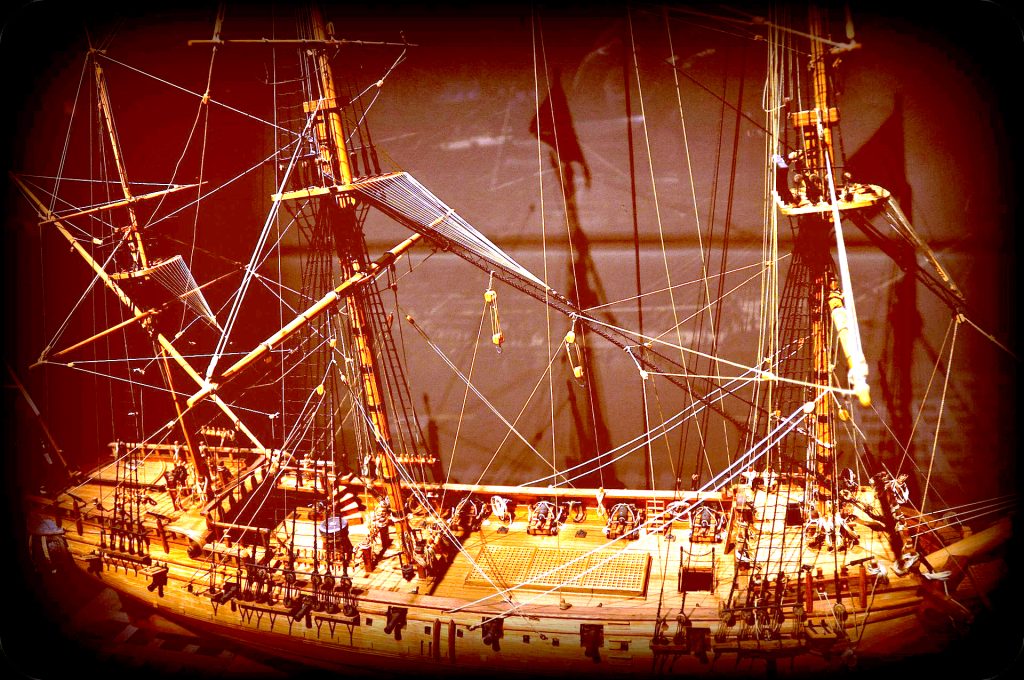Return of the Pirate Round
The Pirate Round was a sailing route followed by many, mainly English, pirates, during the late 17th and early 18th centuries. And, spanning the years 1719 to 1721, Edward England, John Taylor, Olivier Levasseur, and Christopher Condent plied the seas out of Madagascar with Taylor and Levasseur reaping the greatest bounty in the history of the Golden Age of Piracy. That was the plunder of the Portuguese East Indiaman Nossa Senhora Do Cabo at Réunion Island in the Indian ocean east of Madagascar in 1721, heisting diamonds and other treasures worth approximately £800,000 ($962,000.)
Condent was a skilled ship’s Captain. But England was not, hence he was marooned on Comoros, an archipelago island at the northern end of the Mozambique Channel off the eastern coast of Africa, by Taylor and Levasseur in 1721, and died shortly afterward. Despite the success of Taylor and Levasseur, the Pirate Round quickly declined again with Edward Teach, the notorious “Blackbeard”, killed in battle with British Navy Lieutenant Robert Maynard’s navy ship HMS Pearl.

Pirates of the era
Many of the most reknowned pirates in historical lore originated from this Golden Age of Piracy, such as;
• “Black Sam” Bellamy, captain of the Whydah Gally ship, who was lost in a storm off Cape Cod in 1717. Bellamy became known for his mercy and generosity toward those he captured on his raids. And his reputation earned him another nickname, the “Prince of Pirates” so he likened himself to Robin Hood, with his crew calling themselves “Robin Hood’s Men”.
• Stede Bonnet, a wealthy Barbadian land owner turned pirate merely in search of adventure and who captained a 10-gun sloop named the Revenge that raided ships off the Virginia coast in 1717. He was caught and hanged in 1718.
• Henry Avery, one of the few foremost pirate captains to retire with his loot without being arrested or killed in battle. He is famous for capturing the spectacularly rich Mogul ship Ganj-i-Sawai in 1695.
• Olivier Levasseur, aka La Buse, the foremost French pirate in Nassau who was often associated with Hornigold, Bellamy, Kennedy, and Taylor.
• William Fly, an English pirate who raided New England shipping fleets over a three months span in 1726 until he was captured by the crew of a vessel he had seized then hanged in Boston, Massachusetts by that same crew and his body publicly exhibited as a warning to other pirates.
• William “Captain” Kidd, executed for piracy at Execution Dock, London in 1701, is famous for the “buried treasure” he supposedly left behind.
• Edward Low, born in Westminster, was active 1721–1724, was never captured, and was notorious for torturing his victims before killing them; he would cut off their ears, lips, and noses.

• Henry Morgan, was a buccaneer who raided the Spaniards and took Panama City before burning it to the ground. He was to be executed in England, but was instead knighted and made governor of Jamaica. He died a natural death in 1688.
• John “Calico Jack” Rackham, celebrated for his partnership with female pirates Anne Bonny and Mary Read, was captured then hanged outside Port Royal, Jamaica, in 1720.
• Bartholomew “Black Bart” Roberts, is widely considered to be the most successful Western pirate of all time with over 400 ship captures.
• Edward “Blackbeard” Teach (Thatch), active from 1716 to 1718, is perhaps the most notorious pirate among English-speaking nations. Blackbeard’s most famous ship was the Queen Anne’s Revenge, named in response to the end of Queen Anne’s War. He was killed by one of British Lieutenant Robert Maynard’s crewmen in 1718.
• Charles Vane, a particularly violent and unremorseful pirate, who served under Henry Jennings before striking out on his own. Harsh and unpopular with his crew, Vane was marooned before being captured and hanged in 1721.
• Benjamin Hornigold, an English pirate who helped found the Nassau Republic of Pirates and mentored Blackbeard before taking a royal pardon and becoming a pirate hunter.
• Amaro Pargo, a prominent Spanish corsair who dominated the route between Cádiz and the Caribbean. His figure has been wrapped in a halo of romanticism and legend that have linked him to piracy, hidden treasures, and illicit romances. On the marble headstone of his tomb in San Cristóbal de La Laguna is engraved skull and crossbones winking his right eye.
Female pirates
The best-known female pirates were Anne Bonny, Mary Read, and Rachel Wall.
• Anne Bonny (1697–1721) developed a notorious reputation in Nassau. When she was unable to leave an earlier marriage, she eloped with her lover, Calico Jack Rackham.
• Mary Read had been dressed as a boy all her life by her mother and had spent time in the British military. She came to the West Indies (Caribbean) after leaving her husband and joined Calico Jack’s crew after he attacked a ship she had been aboard. She divulged her gender only to Bonny at first, but revealed herself openly when accused by Rackham of having an affair with Bonny.
The nature of the relationships between Bonny, Read, and Rackham have been speculated to be romantic though there is no definitive proof. When their ship was attacked in 1720, Bonny, Read, and an unknown man were the only ones to defend it because all the other crew members were too drunk to fight and, in the end, they were captured and arrested. After their capture, both women were convicted of piracy and sentenced to death, but they deferred their executions by claiming to be pregnant. Read died in jail months later, possibly of a fever or complications from childbirth. Bonny disappeared from historical documents, and no record of her execution nor a childbirth exist.
Barbary pirates or privateers
The Barbary pirates were pirates and privateers that operated from the coastal regions of the “Barbary coast” of the North African ports of Algiers, Morocco, Salé, Tripoli, and Tunis, preying on shipping in the western Mediterranean Sea as well as on ships transiting to Asia around Africa from the time of the Crusades until the early 19th century. They frequently attacked the coastal villages and towns of Italy, Spain and the Mediterranean islands resulting in long stretches of the Italian and Spanish coasts being almost completely abandoned by their inhabitants; since the 17th century, Barbary pirates occasionally crossed the threshold of the Atlantic and struck as far north as Iceland. Between 1 million and 1.25 million Europeans were captured by Barbary pirates and sold as slaves in Northern Africa between the 16th and 19th centuries.
Barbary pirates also flourished in the early 17th century as new and improved sailing rigs enabled North African raiders to brave the Atlantic for the first time as well as Mediterranean waters and more than 20,000 captives were said to be imprisoned in Algiers alone. The rich were allowed to redeem themselves, but the poor were condemned to slavery. Their masters would, on occasion, allow them to secure freedom by professing Islam. Many people of good social position, Germans, Italians, Spaniards, and English travelers in the south, were captives for a time
In 1627, Iceland was subjected to raids branded as the Turkish Abductions. Murat Reis, an Ottoman privateer and admiral, who served in the Ottoman Navy, is believed to have taken 400 prisoners; 242 of the captives were later sold into slavery on the Barbary Coast. The pirates took only young people and those in good physical condition. Any who resisted were killed, and all the elderly people were gathered into a church that was then set afire.
One of the stereotypical features of a pirate in popular culture, the eye patch, is attributed to Rahmah ibn Jabir al-Jalahimah who was a pirate and Arab ruler in the Persian Gulf region and was renowned as the most successful and the most generally tolerated pirate that ever sailed the seas. As a pirate his reputation was for being ruthless and fearless, and he wore an eyepatch having lost an eye in battle.
Whilst the Golden Age of European and American pirates is generally considered to have ended between 1710 and 1730, the prosperity of the Barbary pirates continued until the early 19th century. Unlike the European naval powers, the young United States refused to pay tribute to the Barbary states and responded with the First Barbary War and the Second Barbary War against North Africa, when the Barbary pirates captured and enslaved American sailors. Although the U.S. had only limited success in these wars, France and Great Britain, with their more powerful navies, soon followed suit and stamped out the Barbary raiders.
Buccaneers
Operated mainly in the Caribbean. They originated in Tortuga around the 17th century as hunters, but became “pirates” when government officials would pay groups of men to attack and loot Spanish ships. These buccaneers would later begin attacking any ship of value, enemy or not.
Privateers;
Privateers were private persons who engaged in maritime warfare under a commission of war. The commissions were known as “letters of marque”, which gave them the authority to raid enemy ships with exemption from piracy charges.
Decline of piracy;
By the early 18th century, tolerance for privateers was wearing thin by all nations and the Treaty of Utrecht that ended the War of the Spanish Succession resulted in a glut of trained and unemployed sailors that was both a blessing and a curse for all pirates. Initially, the surplus of men had caused the number of them to multiply significantly. This inevitably led to the pillaging of more ships, which put a greater strain on trade for all European nations. However, in response, European nations bolstered their own navies to offer greater protection for merchants and to hunt down pirates. And the excess of skilled sailors meant there was a large pool that could be recruited into national navies as well.
Piracy was clearly on a strong decline by 1720 and the Golden Age of Piracy did not last the decade. The events of the latter half of 1718, including the arrival of Governor Woodes Rogers in Nassau, represent a turning point in the history of piracy in the New World. Without a safe base and with growing pressure from naval forces, the rovers lost their momentum. The lure of the Spanish treasures had faded, and the hunters gradually became the hunted. By early 1719, the remaining pirates were on the run. Most of them headed for West Africa, seizing poorly defended slaver vessels.
Effect on popular culture;
Stories and histories from the Golden Age form the foundation for many modern depictions of pirates and piracy.
Various claims and speculation about their overall image, attire, fashion, dress code, etc. have been made and has contributed to their fanciful mystery and lore. For example, men wore earrings as the value of the gold or silver earring was meant to pay for their burial if they were lost at sea and their body washed ashore. They were also worn for superstitious reasons, believing the precious metals had magical healing powers
More recently, even less accurate depictions of historical-era pirates like the “International Talk Like a Pirate Day”, a parodic holiday created in 1995 by John Baur Ol’ Chumbucket and Mark Summers aka Cap’n Slappy, of Albany, Oregon, who proclaimed September 19 each year as the day when everyone in the world should talk like a pirate, have advanced to the forefront. However, these phenomena have only served to advance the romantic image of piracy and its treasure-burying swashbucklers in popular culture.
